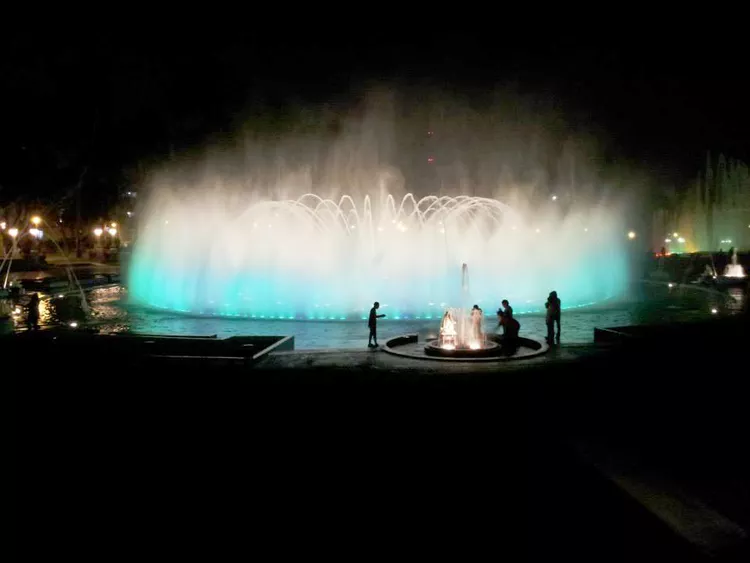Summary
Circuito Mágico del Agua: The Largest Fountain in the World
The Circuito Mágico del Agua (Magic Water Circuit) is a remarkable series of illuminated water fountains located in Lima, Peru. Initially, the idea of visiting a water fountain park might seem unexciting. However, the scale and beauty of this complex are truly astonishing. This public water fountain has been recognized by Guinness World Records as the largest of its kind globally.
Location and Park Features
Having visited the Circuito Mágico del Agua multiple times, it’s easy to appreciate why it’s a popular destination for families and a memorable experience for adult travelers. The entrance fee is affordable, ensuring that it fits within your travel budget. The park operates from 3:00 PM to 10:30 PM from Wednesday to Sunday, with the fountains particularly stunning at night.
The Circuito Mágico del Agua is situated within the Parque de la Reserva, a 19-acre (eight hectare) park that was inaugurated in 1929. Located between Avenida Arequipa and Paseo de la Republica, the park underwent revitalization in 2007 with the addition of the Magic Water Circuit, which consists of 13 illuminated fountains.
The 13 Fountains of the Magic Water Circuit
Lima’s Circuito Mágico del Agua features an impressive array of 13 illuminated fountains. Most of these fountains include interactive elements, so expect to get wet during your visit. Entering from the Avenida Arequipa side, you will encounter the following fountains:
- Fuente del Arco Iris (Rainbow Fountain): A series of parallel fountains of varying heights, creating the impression of a rainbow.
- Fuente de la Armonía (Fountain of Harmony): A pyramid-shaped structure formed by jets of water, resembling a solid form.
- Fuente Tangüis (Tangüis Fountain): A whimsical garden featuring fountains shaped like flowers, named after the notable agriculturalist Fermín Tangüis.
- Cúpula Visitable (Walk-in Dome): Jets of water create a dome that visitors can walk under without getting wet, unless someone disrupts the flow.
- Fuente de la Ilusión (Fountain of the Illusion): An elegant fountain with streams of water appearing to defy direction, surrounded by multicolored clouds of spray.
- Túnel de las Sorpresas (Tunnel of Surprises): A unique tunnel created by cascading water arcs, measuring 38 yards (35 m) long.
- Laberinto del Ensueño (Maze of the Dream): A fun maze where visitors navigate through vertical walls of water; be prepared to get splashed!
- Fuente de la Vida (Fountain of Life): A central spiraling structure that sprouts multiple fountains.
- Fuente de Los Niños (Fountain of the Children): Randomly emerging fountains from an illuminated grid.
- Fuente de las Tradiciones (Fountain of Traditions): A renovated fountain that incorporates traditional sculptures.
- Río de los Deseos (River of Wishes): A winding waterway adorned with fountains.
- Fuente Mágica (Magic Fountain): The highlight of the park, capable of shooting water over 87 yards (80 m) into the sky.
- Fuente de la Fantasía (Fantasia Fountain): The park’s flagship fountain hosting a choreographed spectacle of lasers, water, and music, showcased three times nightly.
Educational Opportunities
While the shimmering fountains are undeniably the main attraction at Parque de la Reserva, the Circuito Mágico del Agua also provides educational insights. The Túnel de Exposición, located beneath Avenida Petit Thouars, presents valuable information about Lima’s water system. Visitors can discover the sources of Lima’s water, the challenges in maintaining the infrastructure, and its economic and environmental impacts.
Above ground, various exhibitions are frequently hosted, particularly near the Fuente de la Ilusión and the statue of Antonio José de Sucre. For instance, in May 2012, a photographic display showcasing historical images of Machu Picchu was on view.
Getting to Parque de la Reserva
The most straightforward way to reach Parque de la Reserva and the Circuito Mágico del Agua is by taking a taxi. If you’re starting from Parque Kennedy in Miraflores, the fare is quite reasonable, especially if you’re traveling with companions. Alternatively, consider using one of Lima’s minibusses along Avenida Arequipa to access the park. Another efficient option is using Lima’s Metropolitano bus system; simply disembark at the Estadio Nacional Station, which is conveniently located next to the park. The primary entrance lies just off Avenida Arequipa.





